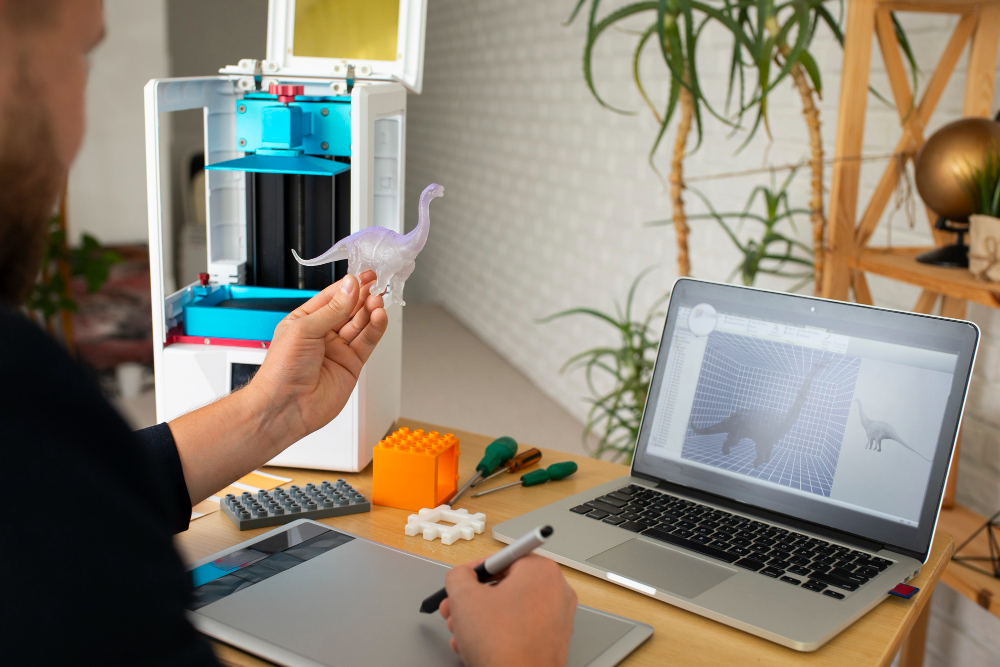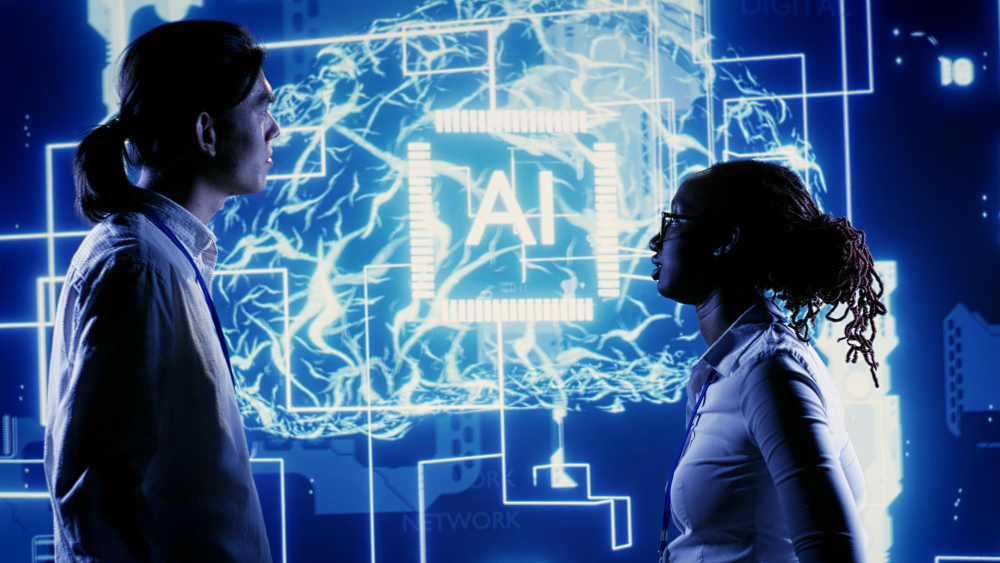In game development process, staying ahead of the curve is crucial for success. An advancement in this process that has been reshaping the landscape is AI 3D Model Generator. Moreover, these tools leverage AI to generate 3D models, offering game developers a powerful ally in their creation.
This blog will discuss the significance of AI 3D Model Generators, discuss its key features, and its impact on game design.
1. Brief: AI 3D Model Generator
AI 3D Model Generator operate on the principle of generative AI, where a model-based system interprets text prompts and transforms them into intricate 3D models. Consequently, the ease of use and user-friendly interfaces make these tools accessible and less time consuming to game developers. Nevertheless, the extensive library of pre-generated models adds a layer of convenience for users.
Key features to generate ai model with this tool
Real-Time Collaboration of ai 3d model generator
Say goodbye to the time consuming process and inefficiencies of traditional design. AI Generator boast a collaboration feature that allow teams to work seamlessly. This feature promotes communication and coordination, ensuring that everyone is on the same page throughout the journey.
Easy Customization: create Models to Your Vision
The 3d model generation tool empowers developers to create models or object according to their specific requirements. Whether it’s adjusting dimensions, textures, or fine-tuning style, this tool puts the creative control to the team, allowing for a personalized touch in every project.
Text Input Magic: Generating 3D Models Made Simple
The ability to generate 3D models from text to 3d is a game-changer. Developers can now create their images in plain text, incorporating body measurements, images, and details, and the AI takes care of the rest. This not only saves time but also opens up possibilities for those who may not have extensive design skills.
What is role of Generative AI in creating text to 3d model?
Generative AI plays a pivotal role in the transition from text to 3D model, transforming plain description into object. This innovative process allows for free-flowing creativity as users describe their vision in simple line of text. By efficiently interpreting these descriptions, it create detailed and accurate 3D models. This transformative capability not only empowers users with a free and intuitive design process but also ensures that the generated models align with the provided textual input.
2. AI 3D Model Generator and its impact in product design
AI 3D Model Generators have redefined product design by streamlining the process, enabling rapid prototyping and iteration. Their impact lies in the ability to generate intricate 3D models with precision through text descriptions, accelerating the product development lifecycle. By seamlessly transforming ideas into tangible digital assets, these generators empower designers to visualize, refine, and bring innovative products to market faster than ever before. You can easily download these 3d renders created from image for implementation in product design.
Different types of AI models used in 3D model generation
AI has given rise to a multitude of AI models to tackle distinct challenges and tasks. Machine learning, encompasses diverse approaches such as supervised, unsupervised, and reinforcement learning. Deep learning 3d models, like neural networks, convolutional neural networks (CNNs), and recurrent neural networks (RNNs), excel in tasks requiring intricate pattern recognition, particularly in image and sequential data processing. Generative models, including Generative Adversarial Networks (GANs) and Variational Autoencoders (VAEs), showcase the ability to generate realistic outputs, from images to text.
Overview of artificial intelligence 3D models
AI 3D Model Generators lies at the core concept of to create 3D models. Artificial intelligence 3D model offer a transformative overview, enabling to create object from free-flowing textual description. Moreover, the convenience extends with the freedom to download these models in the widely-supported GLB format, enhancing accessibility. Additionally users can seamlessly translate their creative vision into tangible 3D objects, combining precision to create with simplicity. This innovative approach not only empowers developers but also emphasizes the versatility of 3D model generation, available for free download to bring imaginative concepts to life.
AI-generated 3D models from images
One of the groundbreaking capabilities of AI 3D Model Generator is their ability to generate 3D models directly from images. This functionality allows developers to take inspiration from real-world objects, scenes, or even sketches and turn them into dynamic 3D assets. Therefore, this seamless translation to create from 2D to 3D broadens the scope of creativity, providing a bridge between the physical and digital worlds.
Moreover, users can conveniently download the generated models, offering a tangible output derived from real-world inspiration.
Image to 3D model AI techniques
The magic happens when AI algorithms transform static images into dynamic 3D models. Various techniques, such as convolutional neural networks (CNNs) and generative adversarial networks (GANs), play a pivotal role in this process. These techniques enable the AI to extract spatial information, depth, and details from 2D images, creating a three-dimensional representation that mirrors the original visual input.
AI modeling in game development
In the context of game development, AI modeling is a game-changer. It not only expedites the 3D model creation process but also introduces a level of precision and complexity that might be challenging to achieve manually. AI-generated model seamlessly integrate into the game development workflow, offering developers a versatile tool to bring their visions to fruition.

3. Various Applications in Game Design
AI 3D Model Generators redefine game design applications by seamlessly generating intricate 3D objects, offering a diverse library for effortless creation. With an efficient search and save functionality, developers can explore, save, and utilize a multitude of assets, fostering free-flowing creativity in real-time. Supporting the widely-used GLB format ensures easy integration, while the transformative text-to-3D feature and tools enhance descriptive creation and team work. Moreover, these generators bridge imagination and implementation, empowering users to translate idea into tangible game elements.
Enhancing efficiency and creation in the game design process with AI 3D Model generator
AI 3D Model Generator revolutionize game design with rapid prototyping, enabling swift iteration of game elements. Real-time collaboration features facilitate dynamic teamwork, transcending geographical boundaries. Subsequently, the ease of customization empowers developers to tailor assets effortlessly, focusing on creative aspects without complex adjustments. Integrating generative AI with 3D models opens doors to innovative augmented reality experiences, enhancing the overall gaming landscape.
4. Empowering Game Developers with AI 3D Model Generators
AI 3D Model Generators streamline the creative process by transforming textual ideas into tangible 3D assets, ensuring precision. Moreover, the capability to download renders multiple times allows for efficient implementation into diverse aspects of game development. Additionally, developers can easily download these 3d renders, enhancing the aesthetics of their projects and expediting the production timeline. This innovative approach, incorporating real-world image, fuels creativity and provides developers with a versatile toolkit, facilitating the dynamic integration of AI-generated assets into their gaming projects.
5. From Text prompt to Game Ready Assets
The landscape of game design has been revolutionized with the introduction of AI 3D Model Generator. Transitioning seamlessly from a mere text prompt to fully-realized 3D assets, these tools harness the power of generative AI to interpret and translate image into tangible 3D models. This transformative process not only accelerates development timelines but also empowers game designers to bring their ideas to life with unprecedented efficiency.
Using text prompts for creating user friendly 3d model
Game developers can now describe their vision through simple text inputs, allowing the AI to handle the intricacies of model generation. This innovative approach not only caters to individuals with varying levels of design expertise but also fosters a more inclusive and accessible environment for creation of quality in the gaming industry. It democratizes the design process, inviting a broader audience to actively participate in shaping virtual worlds.
Intersection of Generative AI, 3D Model, and Augmented Reality in the 3D Model Generator Tool
The 3D Model Generator Tool explores a transformative intersection of generative AI, 3D models, and augmented reality (AR). Generative AI interprets text prompts, swiftly crafting 3D models, injecting unpredictability and creativity. In addition ,this synergy integrates 3D models into AR experiences, blurring the lines between virtual and physical realms. Moreover, the tool create design processes, offering a vast library of quality pre-generated models for developers to download. The 3D Model Generator Tool streamlines game design and propels the industry into an era of boundless creativity, where virtual experiences transcend traditional gameplay.
6. Challenges and Considerations in AI 3D Model Generator
Challenges to generate 3d models
To create 3D models through AI encounters hurdles like accurately interpreting complex text descriptions and reducing reliance on human labor in certain stages. Challenges arise in refining tools to create highly detailed models, especially when translating from images. Navigating the fine line between speed and precision, converting images to 3D models demands continuous attention. Additionally, mitigating software capability disparities remains a persistent challenge in this dynamic process.
Overcoming obstacles in implementation
To mitigate these challenges, creating robust image recognition services is vital, enhancing the tool’s ability to interpret diverse visual inputs. Emphasis on refining algorithms and integrating efficient image-to-3D conversion techniques ensures the creation of high-quality models. Moreover, streamlining software interfaces and optimizing speed without compromising accuracy are crucial steps. Furthermore, fostering a user-friendly atmosphere is crucial. In addition, comprehensive tutorials empower users, enhancing tool navigation, saving valuable time and resources for businesses.

7. Future Trends in AI 3D Model Generator
Embracing emerging trends, AI 3D Model Generators promise refined text-to-model conversions, style-specific generation, and improved user support. Anticipating a dynamic future, these generators offer exciting advancements in model creation and user experience. Moreover, these cater to the demands of personalized game designs. Concurrently, the broader predictions for AI in game design envision holistic integration, dynamic environments, and narratives shaped by player choices.
AI and game design prompt has speed an era in model generation making it a norm, complemented by AI-driven features. This future promises unparalleled creativity, efficiency, and users with the innovations in the dynamic landscape of gaming.
8. Conclusion
AI 3D Model Generators have revolutionized game design, by creating intricate models in real-time, offering diverse styles and free access to technology. The transformative impact encourages game developers to embrace AI for creativity and efficiency, moreover the future promises even more innovation. Visit 3daily today and access a vast library of AI-generated 3D models. In addition support your vision and give life to your projects with this 3d technology.



